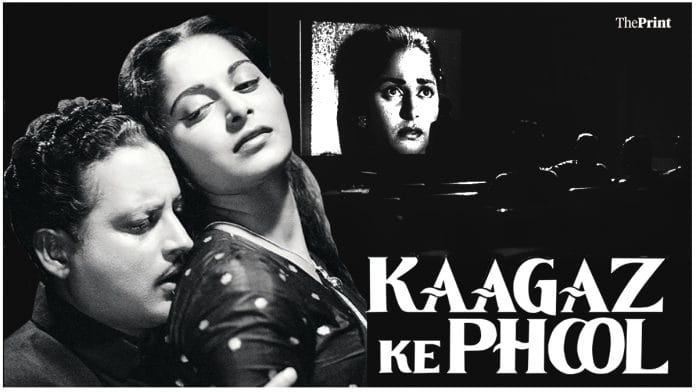It is a truth universally acknowledged that Kaagaz Ke Phool is one of the finest movies ever to flop.
So much has been written about the epic commercial failure of Guru Dutt’s passion project in 1959, now regularly included in lists of best movies ever made — about how it is apparently inspired by his own life and how it marked a technical revolution in Indian cinematography — that one might even feel intimidated writing about it.
But right from the opening credits, “Dekhi zamaane ki yaari, bichhde sabhi baari baari (I have seen the friendships of this era, they all drifted away one by one)”, Kaifi Azmi’s heartbreaking words sung by Mohammed Rafi, melt away any such mundane thoughts.
The movie was arguably Azmi’s big break as a movie lyricist, but the fact that it begins and ends with this haunting song of loneliness is enough to know that he didn’t just write the lyrics for the film, he wrote a whole mood.
In the week of Kaifi Azmi’s death anniversary, spend some time soaking in the beautiful sorrow that is Kaagaz Ke Phool.
Also read: 1942: A Love Story — the swansong that brought R.D. Burman back to stay
Black-and-white masterpiece with shades of real, grey life
The movie made cinematic history as the first in India to be shot in CinemaScope, a lens created by the president of 20th Century Fox. The process of securing the lens, which involved a trip to Paris, and then learning to shoot in a different aspect ratio, was a major production. And because CinemaScope screens existed only in a few theatres in Bombay and perhaps Delhi, the film had to be shot twice, one version for regular screens and one in the new lens. But director and producer Guru Dutt was adamant.
The story follows Suresh Sinha (Guru Dutt), a once-successful film director whose personal life is a mess. He meets Shanti (Waheeda Rehman), who works with a chemist, and eventually she becomes not just an actor, but his muse, while he, her mentor. It seems like the start of a new, happy life for both Suresh and Shanti, and the music, composed by S.D. Burman, follows suit. In stark contrast to the the earlier song, ‘San San San Woh Chali Hawa‘ is a bright, happy song about new hopes and dreams, and the first flush of romance.
But when Suresh and Shanti’s relationship, though never explicitly spelt out, deepens, it causes anguish for his adolescent daughter, Pammi (Baby Naaz) from his estranged wife. The alleged romance is written about in the tabloids, and Pammi, cruelly teased by her classmates, visits Shanti and makes her promise to leave.
Suresh, whose career has meanwhile nosedived, is heartbroken over Shanti’s departure as well as his unsuccessful custody battle for Pammi. He turns to alcohol, and his producers tell him they can’t work with him anymore unless he follows their safe scripts and doesn’t change a word. Unable to take this assault on his creative freedom, Suresh spirals further and further into loneliness, alcoholism and depression, right up until the tragic end.
While Guru Dutt maintained that the movie was an ode to his mentor, Gyan Mukherjee, many believe there is more than a hint of autobiography to it, based on the widely written-about alleged relationship between Dutt and his protégé, Waheeda Rehman. Dutt was married to singer Geeta Roy Chowdhuri (later Geeta Dutt) at the time, and his heavy drinking and the rumours of his passionate romance with Rehman didn’t help.
The commercial failure of Kaagaz Ke Phool, a movie to which Guru Dutt had given his all, was another major blow to the filmmaker, who didn’t direct a single movie after this. Meanwhile, Dutt and Geeta, by now herself struggling with alcoholism, separated, and he died of an overdose of liquor and sleeping pills in 1964, just five years after this movie.
In the writing of her book Ten Years with Guru Dutt: Abrar Alvi’s Journey, Sathya Saran spent a lot of time with Alvi, the acclaimed writer and eventual director, who was Guru Dutt’s filmmaking partner for a decade. Alvi, who wrote the screenplay and dialogues of Kaagaz Ke Phool, told Saran that he believed the masses just couldn’t identify with Suresh’s trauma over his personal heartbreak and his lack of professional creative freedom, given that he was reasonably well off and he still had a job, while they struggled to put two meals on their table.
He believed viewers couldn’t feel for what they saw as the self-indulgent angst of a privileged man. Even if that angst was showcased with the help of some of the most gorgeous cinematography in Hindi cinema.
The play of shadow and light is as much a part of the mood as the music is. Even though the movie bombed at the time, it won two Filmfare awards — for art direction (M.R. Achrekar) and cinematography (V.K. Murthy). The camera is put to exceptionally lovely and imaginative use in the film’s iconic song, ‘Waqt Ne Kiya Kya Haseen Sitam‘. The words “Jaayenge kahaan soojhta nahin, chal pade magar raasta nahin, kya talaash hai kuch pata nahin, bun raha hai dil khwaab dum-ba-dum” (We don’t know where we are going, we have started walking but we don’t know the way, we don’t know what we’re looking for but the heart weaves dreams anyway) are made even more layered and heartbreaking by the fact that they were sung by none other than Geeta Dutt.
Also read: Cinema writer with a golden touch, Abrar Alvi was lost in Guru Dutt’s shadow






